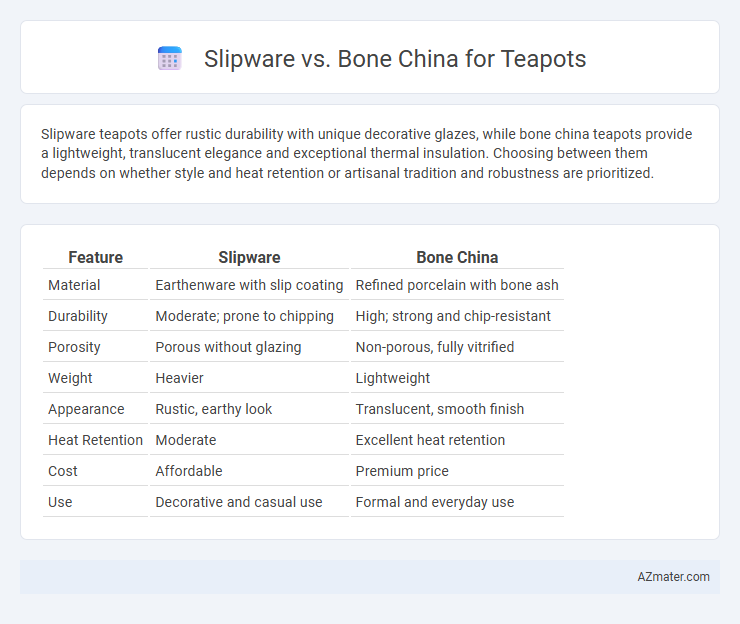Slipware teapots offer rustic durability with unique decorative glazes, while bone china teapots provide a lightweight, translucent elegance and exceptional thermal insulation. Choosing between them depends on whether style and heat retention or artisanal tradition and robustness are prioritized.
Table of Comparison
| Feature | Slipware | Bone China |
|---|---|---|
| Material | Earthenware with slip coating | Refined porcelain with bone ash |
| Durability | Moderate; prone to chipping | High; strong and chip-resistant |
| Porosity | Porous without glazing | Non-porous, fully vitrified |
| Weight | Heavier | Lightweight |
| Appearance | Rustic, earthy look | Translucent, smooth finish |
| Heat Retention | Moderate | Excellent heat retention |
| Cost | Affordable | Premium price |
| Use | Decorative and casual use | Formal and everyday use |
Introduction to Slipware and Bone China Teapots
Slipware teapots are crafted using a traditional pottery technique where liquid clay slip is applied to the surface, creating unique textures and patterns that emphasize rustic aesthetics. Bone china teapots are made from a refined porcelain containing bone ash, offering exceptional strength, translucency, and a delicate, glossy finish prized in fine tea service. Both materials present distinct functional and visual qualities, with slipware prized for its artisanal charm and bone china favored for elegance and durability.
Origins and Historical Background
Slipware originated in ancient pottery traditions, primarily in Europe and Asia, where artisans used liquid clay slip to create decorative designs on earthenware. Bone china, developed in 18th century England, combines bone ash, porcelain, and china clay to create a highly durable, translucent ceramic. Both materials reflect distinct cultural innovations, with slipware emphasizing handcraft and rustic aesthetics, while bone china represents advanced industrial techniques and refinement.
Material Composition and Production Methods
Slipware teapots are crafted using earthenware clay coated with liquid clay slip, then decorated with slip trailing or sgraffito techniques before firing at lower temperatures, resulting in a porous but charmingly rustic finish. Bone china teapots consist of a refined blend of bone ash, kaolin, and feldspar, fired at higher temperatures to achieve translucency and exceptional strength, making them highly durable and chip-resistant. The production of bone china involves meticulous milling and precision firing, whereas slipware emphasizes artisanal handcrafting and decorative slip application, highlighting distinct material and manufacturing contrasts.
Aesthetic Differences: Texture, Color, and Design
Slipware teapots showcase a rustic, tactile texture with earthy, hand-crafted glaze patterns that emphasize vibrant, variegated colors and artisanal designs unique to traditional pottery techniques. Bone china teapots offer a smooth, polished surface with a translucent, delicate appearance, characterized by soft pastels or pristine whites and intricate floral or classical motifs reflecting refined elegance. The contrast lies in slipware's organic, bold visuals versus bone china's refined, delicate aesthetic, catering to distinct stylistic preferences in teapot collections.
Durability and Longevity Comparison
Slipware teapots exhibit a robust durability due to their thick, hand-coated clay body and natural slip glaze, making them resistant to chipping and ideal for everyday use. Bone china teapots, renowned for their high alumina content and fine vitrification, offer exceptional strength with a lightweight feel but can be more susceptible to impact damage compared to slipware. Over time, slipware tends to maintain structural integrity longer in rough handling scenarios, whereas bone china excels in preserving delicate aesthetics with proper care.
Heat Retention and Brewing Performance
Slipware teapots offer moderate heat retention due to their thicker ceramic walls but may cool faster than bone china during brewing. Bone china excels in heat retention with its dense, fine porcelain composition, maintaining optimal temperature for longer steeping times. The better heat retention of bone china enhances brewing performance by ensuring consistent infusion and maximizing flavor extraction from tea leaves.
Maintenance and Cleaning Requirements
Slipware teapots require gentle cleaning with mild soap and a soft cloth to preserve their decorative slip surface and prevent surface damage. Bone china teapots are more durable against stains but should be hand-washed to avoid cracks and maintain their translucent quality. Both materials benefit from avoiding harsh abrasives and temperature extremes to ensure longevity and aesthetic appeal.
Price Range and Accessibility
Slipware teapots are generally more affordable, with prices ranging from $20 to $100, making them accessible for everyday use and casual collectors. Bone china teapots tend to be higher-priced, typically between $50 and $300, reflecting their fine craftsmanship, durability, and elegant appearance. Availability of slipware is widespread through both artisan markets and online shops, whereas bone china teapots are commonly found in specialty stores and upscale retailers.
Popular Brands and Makers
Slipware teapots crafted by renowned brands like Heath Ceramics and Simon Leach pottery offer rustic charm with their hand-applied slip decorations that highlight artisanal craftsmanship. Bone china teapots from prestigious makers such as Wedgwood and Royal Worcester are prized for their delicate translucency, refined aesthetics, and durability, making them staples in luxury tea sets. Both slipware and bone china teapots cater to different preferences, with slipware appealing to collectors of handcrafted pottery and bone china favored by those seeking elegant, timeless designs.
Choosing the Right Teapot: Slipware or Bone China?
Slipware teapots offer rustic charm with their hand-crafted, earthy texture and excellent heat retention, ideal for traditional tea brewing methods. Bone china teapots, known for their delicate translucence and lightweight durability, provide a refined aesthetic and maintain tea temperature without imparting flavors. Choosing between slipware and bone china depends on your preference for style, heat retention, and the type of tea experience desired.

Infographic: Slipware vs Bone china for Teapot
 azmater.com
azmater.com